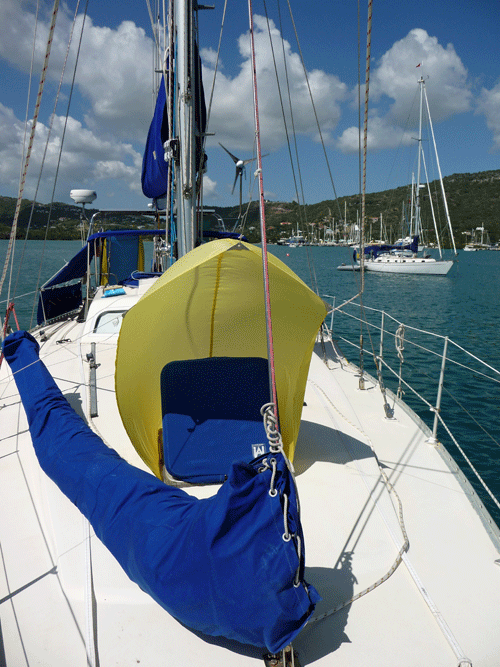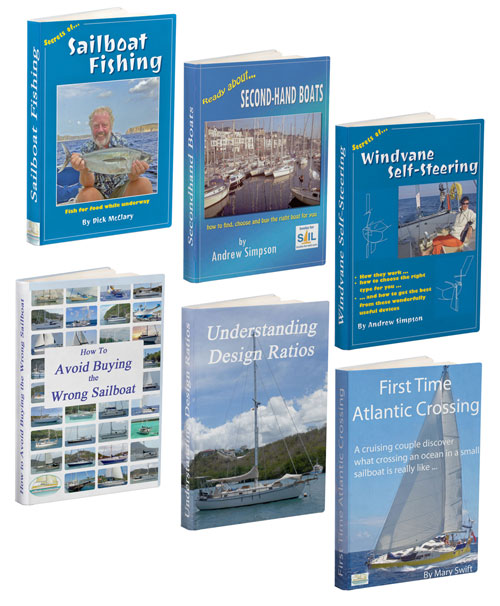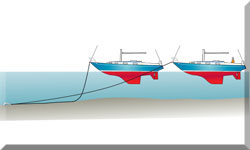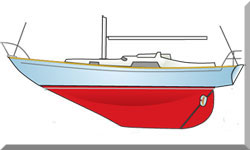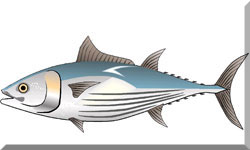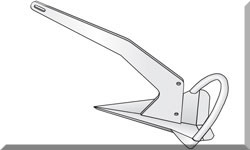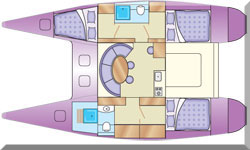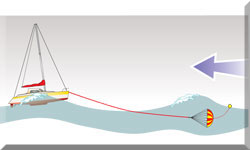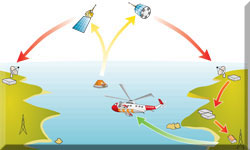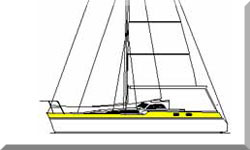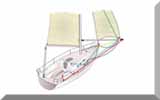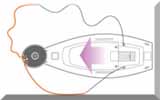- Home
- Cruising Sailboats
- Sailboat Interiors for Offshore Sailing
Sailboat Interiors for Offshore Sailing
In a Nutshell...
For serious offshore cruising, Practical Sailboat Interiors prioritise function, security, and a sensible two-to-four person crew over the common, multi-berth, hotel-style layouts seen in many production boats. The key is finding stable, central locations for the galley, heads, and dedicated sea berths—ideally at the foot of the companionway.
- Sea Berths: Must be single, narrow (700mm ideal) and parallel to the centreline, always fitted with robust lee clot
- Galley & Heads: Located in the most stable area, aft near the companionway. The galley should be U or L-shaped; the heads should be single.
- Safety & Storage: Continuous handholds are non-negotiable. One aft double cabin should often be sacrificed for a cavernous Bosun's Locker for essential offshore gear.
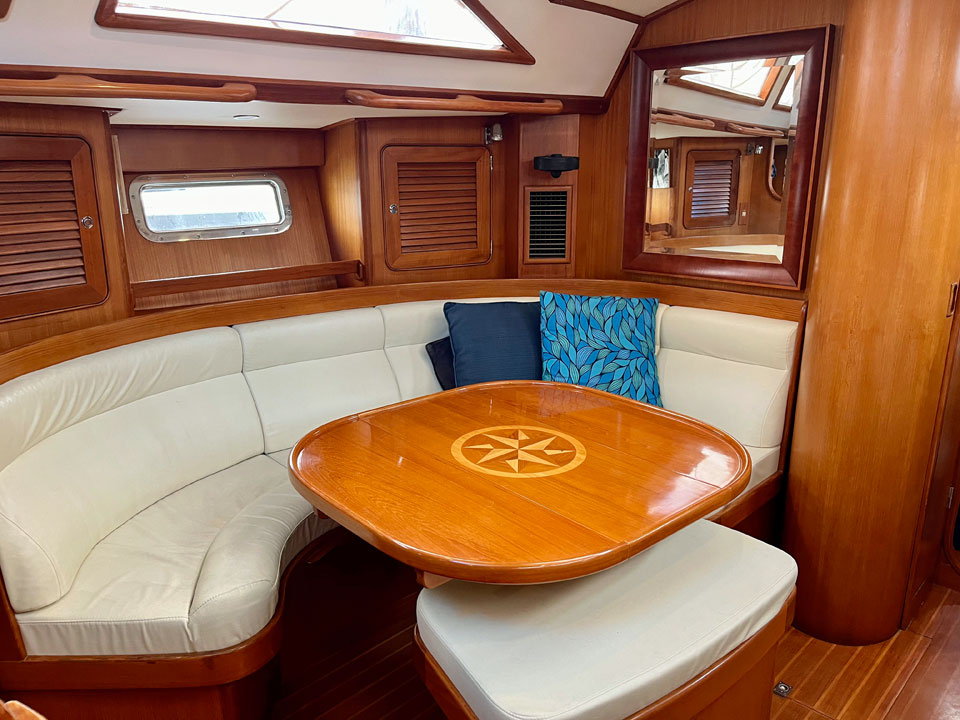 Most satisfactory for dining at anchor, but when beating to windward in a seaway? Probably not so much...
Most satisfactory for dining at anchor, but when beating to windward in a seaway? Probably not so much...Table of Contents
- Coastal Cruiser Versus Ocean Voyager: A Critical Difference
- Practical Layout: Prioritising a Small Crew
- Sleeping Underway: The Sea Berth
- The Galley: Cookery in a Rough Seaway
- The Command Centre: Designing an Offshore Navigation Station
- Managing the Microclimate: Ventilation, Light & Insulation
- Moving Safely Below: The Importance of Handholds & Bracing
- Summing Up
- Frequently Asked Questions
Coastal Cruiser Versus Ocean Voyager: A Critical Difference
When you’re standing on the pontoon, looking at a sparkling new production yacht, the luxurious, cavernous spaces below decks can be instantly alluring. You see wide double berths, a dinette fit for a small dinner party, and multiple heads compartments. It's easy to get swept up in the dream of coastal cruising with a boatload of friends. Yet, as an experienced ocean sailor, I can tell you that the interior that works for a pleasant weekend potter along the coast is often utterly impractical—and sometimes even unsafe—when you’re 500 miles offshore, beating into a Force 6.
Offshore sailing demands an interior design where every feature serves the primary goal: safe, comfortable passage-making for a small, professional crew. This isn't about luxury; it’s about survival, rest, and the efficient operation of the vessel. We need to cut through the marketing fluff and focus on what truly defines a Practical Sailboat Interior for the rigours of the open ocean.
| Feature | Coastal/Inshore Layout | Offshore/Ocean Layout |
|---|---|---|
| Primary Goal | Maximise static comfort & guest capacity | Maximise security & crew efficiency underway |
| Sleeping | Double berths everywhere, often curved saloon seats | Dedicated, single sea berths with lee cloths; doubles used only in port |
| Galley | Forward in the saloon; straight counter; minimal fiddles | Aft near companionway; U or L-shape; secure harness points |
| Heads | Multiple compartments (loo/crew ratio is low) | Single, strategically placed heads; usually aft near the companionway |
| Storage | Limited, small cockpit lockers | Large 'Bosun's Locker' (sometimes converted from a cabin) for sails, spares & warps |
Practical Layout: Prioritising a Small Crew
The first rule of a practical interior for offshore work is simple: it won't be designed for a party of eight. Most long-distance cruisers are crewed by a couple, perhaps supplemented by one or two others for a particularly long or arduous ocean passage. Four is a good, workable maximum on a yacht of 38-45 feet.
Rethinking Berths & Storage
That production boat's two aft double cabins looked lovely, but those twin double berths hog space that is better utilised for utility and storage.
- The Bosun's Locker Conversion: One of the aft double berths should seriously be considered for conversion into a massive Bosun's Locker (or 'garage'). This space, often accessed through the wet locker or an aft heads, is vital for stowing the real offshore kit: warps, fenders, spare sails, dinghy, and outboard motor. On our boat, Alacazam, we wouldn't be without this essential gear storage.
- Forecabin: The forward 'vee berth' double is often unusable in a rough seaway due to the violent pitching motion. Converting it to two comfortable single berths, with an optional infill, is a much more flexible and sensible compromise.
- The Single Heads: Two heads on a sub-50ft cruising boat are simply a ludicrous waste of valuable, stable space. The single sensible location for the heads is aft, at the foot of the companionway. Why? Because when it’s lashing down and you need the loo, you don’t want a crew member in dripping foul-weather gear traipsing through the entire saloon accommodation just to get there.
These core layout decisions—crew size, storage, and utility placement—define whether a boat can manage a weekend trip or a trans-ocean passage, all of which ultimately contribute to The Essential Features of All Good Cruising Sailboats.
Sleeping Underway: The Sea Berth
This is where the distinction between coastal and offshore design becomes most apparent. A double berth is only usable when the boat is flat and level in a calm anchorage. When the boat is heeling, only a designated sea berth is viable.
Sea Berth Specifications
A good sea berth must:
- Be Parallel to the Centreline: Crucially, it must run fore and aft. Lying head-down on one tack and head-up on the other is an express route to a terrible night’s sleep and a grumpy watch.
- Be Secure & Narrow: The ideal width is between 700mm and 750mm. 600mm is the absolute minimum. Any wider and you’ll roll from side to side inside the berth. The minimum length should be 2m.
- Be Fitted with Lee Cloths: These are non-negotiable. Lee cloths (or bunk boards) are canvas or netting panels that snap or hook into place, forming a physical barrier to keep the occupant snugly in place when the boat is heeling or rolling violently. They need a gap of around 500mm at the head for ventilation.
The best types of sea berths typically found in highly functional interiors are:
| Berth Type | Location & Benefit | Offshore Suitability |
|---|---|---|
| Pilot Berths | Outboard, high up; most stable on the windward side when heeled. Do not interfere with saloon use. | Excellent |
| Settee Berths | Saloon seating; stable mid-ships area. Often pull out to increase width. Requires good lee cloths. | Very Good |
| Quarter Berths | Under the cockpit; out of the way. Can be hot, noisy, and difficult to access in a hurry. | Acceptable |
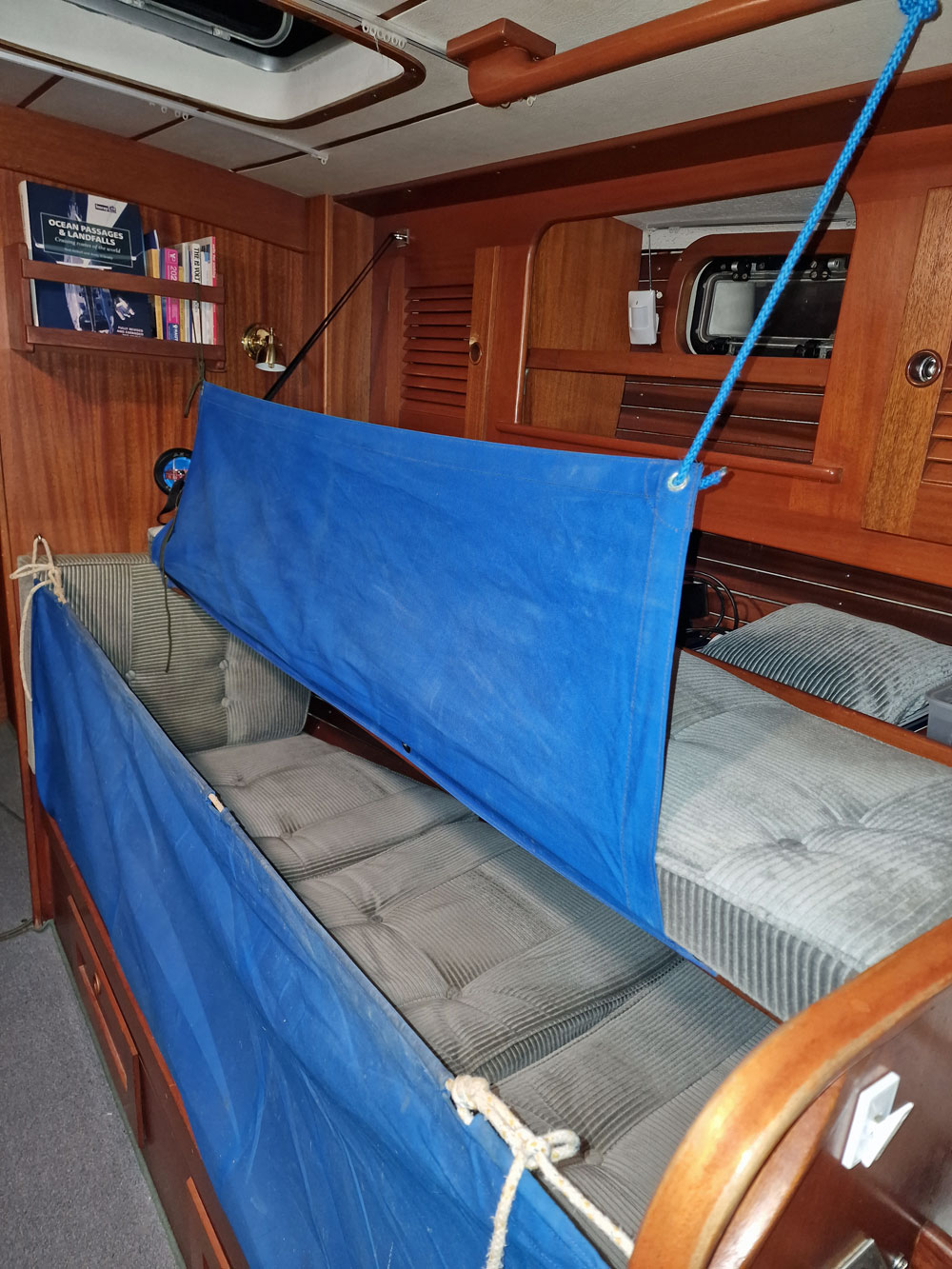 One up, one down. A pilot berth and a saloon berth, each with essential leecloths
One up, one down. A pilot berth and a saloon berth, each with essential leeclothsOn Alacazam, we sacrificed a traditional sit-down navigation area in favour of a dedicated, permanent sea berth located right at the foot of the companionway. This has proven to be an incredibly practical compromise, allowing a wet, exhausted crew to collapse straight into it without wetting the main saloon.
The Galley: Cookery in a Rough Seaway
As an ocean sailor, I believe the galley is the most critical part of an offshore interior, because a well-fed crew is a happy and competent one. The cook needs security and stability above all else—this is a workspace, not a show kitchen.
As we've found on many long trips, the galley is best located further aft, next to the companionway. This is the most stable part of the boat, minimising pitch and roll.
- Shape & Security: It should be a secure U-shaped or L-shaped configuration. This design allows the cook to brace themselves securely against the cabinetry or counter on at least two sides, leaving both hands free for cooking. When facing a big sea, we always ensure the cook wears a short safety strap, clipped to a robust eye-bolt near the stove.
- Stove & Fuel: The cooker must be gimballed, with robust, high fiddles to prevent pots from sliding off. For long passages, diesel or propane (LPG) are the most common fuels. Ensure the gas locker is ventilated and sealed from the interior accommodation.
- Sinks: A deep, single-basin sink is far superior to a shallow double sink. It minimises sloshing and splashing in a seaway, and the water stays contained. Crucially, the sink should be on the boat's centreline or inboard side of the galley to drain reliably on both tacks.
- Dry Storage: Accessible, secure dry storage for essential foods (pasta, tinned goods) should be available right in the galley area. Every cupboard must have robust, positive latches—a simple spring catch won't cut it when the boat slams off a wave.
For more on this topic, take a look at Choosing the Best Sailboat Galley Layout...
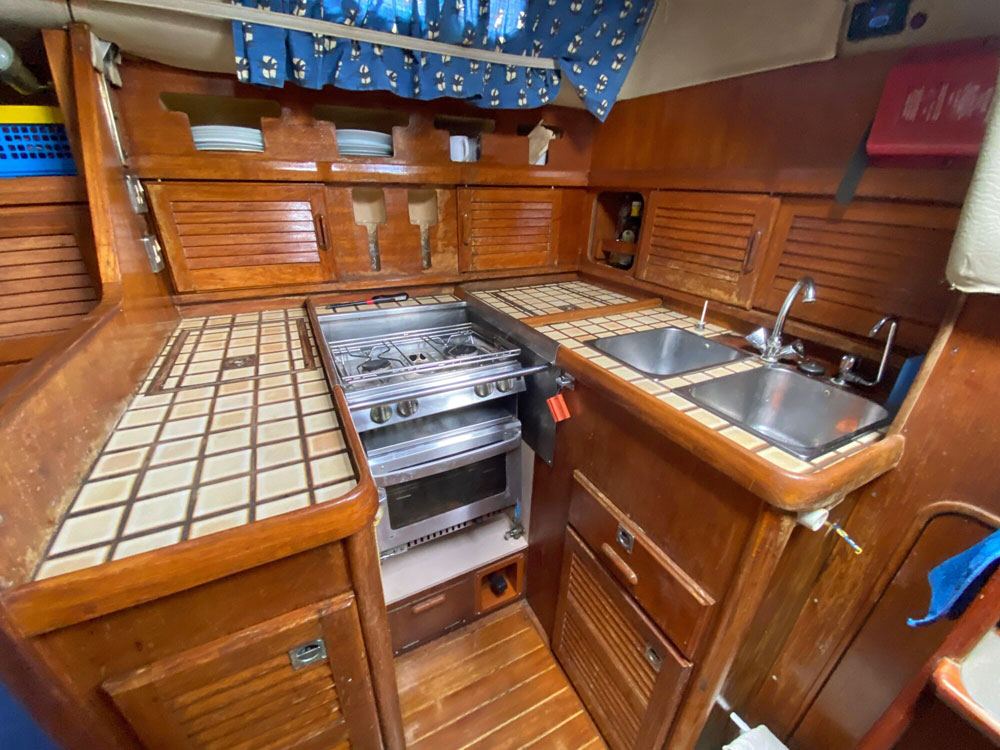 Where the galley should be—at the foot of the companionway steps
Where the galley should be—at the foot of the companionway stepsThe Command Centre: Designing an Offshore Navigation Station
Despite the prevalence of chart plotters, a dedicated chart table remains the brain of a serious offshore cruiser, managing communications, paper chartwork, and power. For the experienced sailor, the distinction between a 'chart shelf' and a 'nav station' is paramount.
- The Paper Chart Space: The table surface must be large enough to accommodate a standard UK or international Admiralty paper chart when folded. It must also have a secure lip or fiddle to keep pencils and instruments in place.
- Secure Seating: The nav seat must have a high back, side support, and, crucially, a solid foot brace so the navigator can wedge themselves in on either tack. You can't plot a position or programme a route if you're sliding off the seat.
- Electronics Hub: The station is the nerve centre for electronics. All essential communications equipment—VHF radio, SSB/satellite phone controls, and instrument repeaters—should be ergonomically arranged. The navigator needs to be able to scan the information easily without straining.
- Power Management: The nav station is the natural, most protected home for the boat's DC distribution panel and battery monitoring system. Having this information accessible allows the watch keeper to manage the vessel's critical electrical consumption efficiently on long voyages.
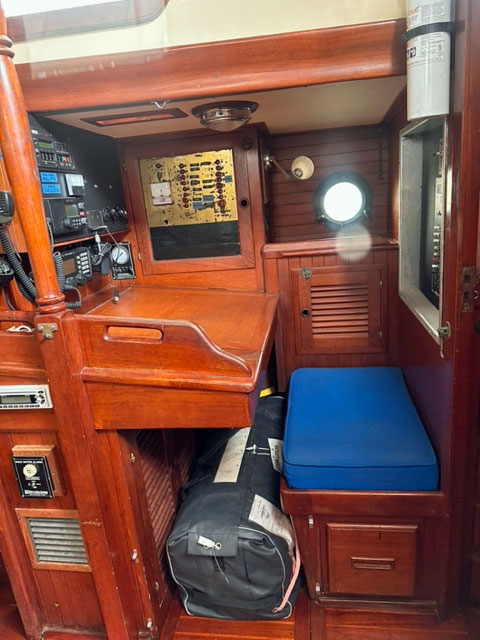 A traditional navigation station—not so sure about the liferaft stowage though...
A traditional navigation station—not so sure about the liferaft stowage though...Managing the Microclimate: Ventilation, Light & Insulation
Offshore life means dealing with extremes: tropical heat, damp condensation, and freezing cold. A practical interior must manage this environment to protect both the crew and the boat itself.Ventilation: Combating the Dreaded Damp
Proper airflow is vital for crew health and preventing mould and mildew from destroying sails and soft furnishings.Lighting: Red for Night, White for Work
- Dorade Vents: These are the gold standard. They are mounted on deck with a box and internal baffle that allow air in while keeping water out, even when buried in a wave. Having multiple Dorades running the length of the boat ensures constant, passive airflow.
- Through-Deck Fans: Simple, low-power fans (often 12V) strategically placed in the aft and fore cabins are excellent for moving stagnant air and drawing out heat.
Your interior lighting should reflect the watch system.Insulation: Staying Warm & Dry
- Red Lighting: Low-intensity red lights are necessary for general illumination during night watches. Red light preserves the crew’s night vision, ensuring they can step on deck and immediately see their surroundings.
- Task Lighting: Focused white light is needed over the galley and the nav station for cooking and working with charts. These lights should be adjustable and separately switched.
Insulation is often overlooked but plays a massive role in crew comfort and condensation control. Insulating the hull and deckhead, particularly in northern latitudes, prevents moist cabin air from hitting a cold surface, drastically reducing condensation. Less condensation means drier bedding, drier clothes, and a happier crew.
Moving Safely Below: The Importance of Handholds & Bracing
When you’re trying to make a cup of tea or grab a chart while the boat is dancing beneath your feet, safety is literally in your hands. A good Practical Sailboat Interior is covered with strategically placed, solid handholds.Summing Up
- The Continuous Grip: You should be able to move from the companionway to the heads, or from the nav station to the galley, without having to let go of a secure grab rail. These need to be mounted strongly to the deckhead and bulkheads, often made of robust teak or stainless steel tubing.
- Bracing Points: Look for explicit bracing points. The best settees have a high back and a secure lip to wedge yourself into. In the galley, a crash bar across the front of the stove is not just for show; it’s an anchor point for the cook in rough seas.
- Non-Slip Flooring: The cabin sole must offer superb traction. While attractive, glossy varnish over traditional teak and holly can be treacherous when wet. Adding non-slip strips or utilising a more aggressively textured composite sole is a simple, effective safety upgrade.
Summing Up
Designing a sailboat interior for the open ocean is an exercise in functional efficiency and safety. Forget the velour and the maximum berth count. An ideal offshore layout is defined by robust, narrow sea berths, a single, aft-located heads, and a secure U or L-shaped galley in the most stable part of the boat. Integrating continuous handholds, a functional navigation station, and a system for managing ventilation and light ensures the vessel is not just a weekend home, but a safe, reliable platform for true ocean passage-making. The design must accommodate the reality of life at sea: water, fatigue, and motion. By prioritising the security and well-being of a small, working crew, you transform a coastal cruiser into a safe and capable ocean voyager.
This article was written by Dick McClary, RYA Yachtmaster and author of the RYA publications 'Offshore Sailing' and 'Fishing Afloat', member of The Yachting Journalists Association (YJA), and erstwhile member of the Ocean Cruising Club (OCC).
Frequently Asked Questions
Why are single seaberths better than a double berth offshore?
Why are single seaberths better than a double berth offshore?
Double berths are generally too wide to offer lateral support when the boat is heeled or pitching, which causes the crew to roll constantly. A dedicated single seaberth, ideally 600-750 mm wide, combined with a full-height lee cloth, firmly holds the crew in place, allowing them to rest and sleep safely and effectively during a watch system.
What does a "positive latch" mean, and why is it essential for offshore sailing?
What does a "positive latch" mean, and why is it essential for offshore sailing?
A positive latch is a locking mechanism that requires a deliberate action (like pressing a button or turning a fastener) to open, rather than relying on a simple spring-loaded catch. They are essential offshore because they prevent lockers and drawers from flying open when the boat is knocked down or subjected to heavy slamming in a seaway, stopping contents from becoming dangerous projectiles.
Why should the galley and heads be located near the companionway?
Why should the galley and heads be located near the companionway?
This location is generally the most stable and least prone to motion (pitching and hobby-horsing) on a monohull. Clustering the galley (for cooking), heads (for personal needs), and a wet locker/watch berth in this area minimises the distance crew have to travel in challenging conditions, increasing safety and reducing fatigue.
Is it a good idea to convert one of the aft cabins into a bosun’s locker?
Is it a good idea to convert one of the aft cabins into a bosun’s locker?
Yes, for serious offshore sailing, converting one aft cabin into a deep, organised bosun’s locker is a valuable trade. It provides a dedicated space to safely and centrally stow heavy, essential gear like spare anchors, chain, warps, fenders, tools, and a rolled dinghy/outboard. This keeps weight low and central, which improves the boat's motion and performance at sea.
What’s the most important consideration for offshore handholds?
What’s the most important consideration for offshore handholds?
They must be continuous and robustly secured with through-bolts, offering a reachable grip at shoulder height from anywhere in the cabin along the traffic paths. The most important test is that a person should never have to take a step without a handhold already in their grasp.
Should I install a watermaker for offshore cruising?
Should I install a watermaker for offshore cruising?
For extended offshore cruising, a watermaker is generally recommended. It removes the necessity of carrying vast quantities of heavy water and ensures a constant supply, which is critical for hygiene and long passages. You must, however, budget for the energy draw and commit to the necessary maintenance, particularly the regular changing of pre-filters.
What is a "pilot berth," and why is it considered the best type of sea berth?Question
What is a "pilot berth," and why is it considered the best type of sea berth?Question
A pilot berth is a single bunk permanently installed high up and outboard, above the settee back in the saloon. It is often considered the best because its high, outboard location can be the most stable when the boat is heeled, and it doesn't obstruct the main saloon area when not in use.
Should an offshore cruising yacht have more than one heads compartment?
Should an offshore cruising yacht have more than one heads compartment?
No, for most cruising yachts under 50 feet, a single heads compartment is generally sufficient and far more practical. Multiple heads waste valuable, stable space. Locating the single heads aft, near the companionway, prevents wet crew members from tracking water through the main cabin.
What is the minimum comfortable width for a sea berth?
What is the minimum comfortable width for a sea berth?
For an adult, the absolute minimum width for a sea berth is 600mm, but between 700mm and 750mm is considered ideal for both comfort and security. This width is narrow enough to prevent excessive rolling when secured by a lee cloth, but wide enough for rest.
What is the primary purpose of red cabin lighting at night?
What is the primary purpose of red cabin lighting at night?
Low-intensity red lighting is used to illuminate the cabin while preserving the crew’s night vision. This ensures that if the off-watch crew is called on deck suddenly, their eyes are already adapted to the darkness, enhancing safety and quick response times.
What makes a single-basin sink better than a double-basin sink offshore?
What makes a single-basin sink better than a double-basin sink offshore?
A single, deep-basin sink is preferable because it better contains water and slosh when the boat is heeling. A double sink is usually shallower and is more prone to spilling water out of the basin and onto the cabin sole in a rough seaway.
Recent Articles
-
Beneteau Oceanis 36CC: Specs, Ratios & Cruising Suitability
Nov 21, 25 06:26 PM
Detailed analysis of the Beneteau Oceanis 36CC centre cockpit sailboat. Includes design ratios, full specifications, and practical assessment of its suitability for experienced offshore and liveaboard… -
Mastering Offshore Seamanship: Heavy Weather & Safety Protocols
Nov 15, 25 05:00 PM
Expert guide to offshore safety and crew protocols. Master heavy weather tactics, self-steering redundancy, watchkeeping systems & essential personal safety gear. -
Transatlantic Passage: Reality, Setup & Lessons Learned
Nov 15, 25 04:41 PM
Offshore Yachtmaster details Alacazam's 3,000-mile transatlantic passage. Practical lessons on downwind rigging, windvane steering, & power generation systems.
